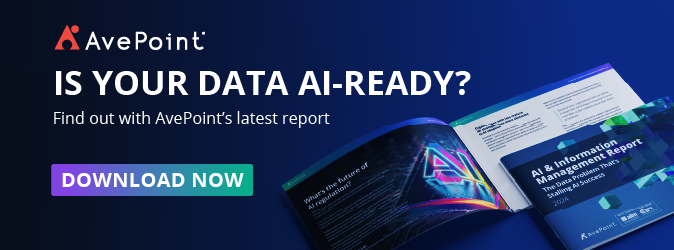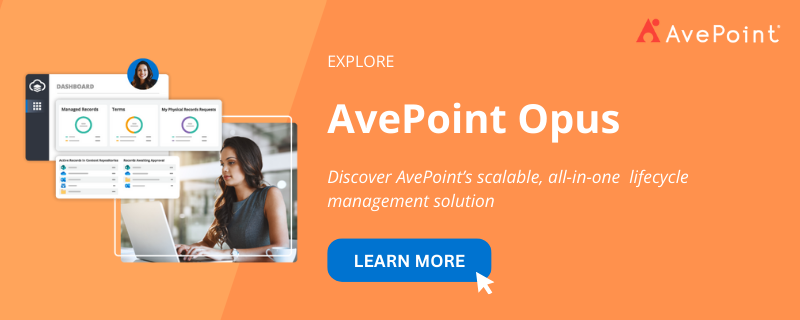Today, data and information have become the driving force behind innovation and growth across industries. As artificial intelligence (AI) and machine learning technologies advance and become more sophisticated, data and information quality and effective management take on even greater significance for organizations striving to stay competitive. This is especially true when organizations are considering or using generative AI tools that have taken the world by storm.
A recent report by the Association for Intelligent Information Management (AIIM) and AvePoint sheds light on the growing significance of effective information management (IM) in the era of AI adoption. The report reveals that a staggering 77% of organizations acknowledge the need to implement new IM measures to keep pace with the increasing integration of AI into their operations.
While the same report reveals that 88% of organizations claim to have an IM strategy in place, a concerning 44% of them lack fundamental elements such as archiving policies, retention guidelines, and lifecycle management solutions.
This deficiency in their IM strategies, coupled with the rapid data growth due to the increasing adoption of AI technologies, is poised to exacerbate IM challenges. As organizations gear up to adapt to this new era of modern work, building an effective IM strategy ensures the accuracy and reliability of data and prepares organizations to fully leverage the power of AI.
What Makes an Effective Information Management Strategy?
Organizations with inadequate IM strategies are more likely to face compromised data and information quality, increased security risks, inefficient storage and resource utilization, and potential non-compliance with regulations. These challenges can have far-reaching consequences, hindering organizational productivity, exposing confidential information to breaches, and incurring substantial costs.
Conversely, an effective IM strategy can drive positive business outcomes, empowering organizations to leverage their data as a strategic asset.
By implementing robust IM practices, organizations can reduce storage and data management costs, mitigate risks, and gain a competitive advantage in the AI-driven workplace.
To be truly effective, an IM strategy must establish control over data throughout its entire lifecycle, from creation to eventual disposal or archival. To achieve this level of control, the following key pillars must be integrated into an organization’s IM processes:
Understand the state of your data
Organizations need to have a comprehensive understanding of the state of their data to make informed decisions. This involves thoroughly analyzing data and information assets across the entire organization.
With this analysis, organizations can then identify critical business data that holds strategic value for the company and decide how to manage and protect it. It also allows organizations to discover redundant, obsolete, or trivial (ROT) content that no longer holds any value and can be safely disposed of to reduce valuable storage space.
By gaining visibility into information assets through comprehensive discovery and analysis, organizations can prioritize and focus their IM efforts on the most valuable and relevant information.
Proactively remove what you don’t need
In the AI-driven world, data growth continues to be rapid and relentless. According to the report, a staggering 64% of organizations are managing at least 1 petabyte (PB) of data, while 41% are grappling with a colossal 500 PB or more.
The presence of outdated and unnecessary data compounds the storage challenge. The report reveals that half of organizations harbor over five years old data, likely containing a substantial amount of ROT content. Even if it’s still required for business or regulatory purposes, it may not need to be stored in the most expensive storage tiers. This aged data occupies storage space and increases the risk of non-compliance with data privacy regulations and potential legal liabilities.
Optimizing storage is then crucial for organizations to reduce costs associated with storage consumption and effectively manage their data assets.
Organizations can free up significant amounts of storage space by eliminating ROT content. This, in turn, can lead to substantial cost savings by reducing the need for additional cloud storage fees.
Furthermore, storage optimization efforts can streamline user efficiency. Moving content that is not regularly accessed but still needs to be retained to cheaper storage not only saves on cost but also ensures that users are searching, accessing, and working on the most up-to-date content. Organizations need data and lifecycle management practices by decluttering the content sources from unnecessary data that can impede efficient operations.
A recent Gartner report showed 47% of users couldn’t find the information they need to do their jobs. But ensuring that information is moved when it’s appropriate to do so, users can find the information they need to make good decisions.
Manage the ongoing lifecycle of your information
After identifying and eliminating ROT content, organizations must focus on implementing robust information lifecycle management practices. This strategic approach ensures that valuable data assets are appropriately managed throughout their entire lifespan, from creation to archival or disposal, reducing risks and supporting compliance efforts.
Effective information lifecycle management is essential for reducing risks associated with mismanagement, such as data breaches, non-compliance with regulations, and legal liabilities. It also supports organizations in maintaining a clean, organized, and efficient information environment, enabling better data accessibility, improved system performance, and enhanced decision-making capabilities.
Information lifecycle management involves assigning comprehensive rules and policies to different information types based on their value, sensitivity, and compliance requirements. These rules dictate a range of actions that should be applied to the data at various stages of its lifecycle, including:
- Storage and Access Controls: Determining where data should be stored, who should have access to it, and what security measures should be implemented to protect its confidentiality and integrity.
- Retention and Archiving: Specifying retention periods for different information types, ensuring that crucial information is preserved for legal, regulatory, or operational purposes while identifying data that can be safely archived or retired to lower-cost storage solutions.
- Record Declaration: Making specific data immutable or Read-Only through a formal record declaration process, ensuring that critical records cannot be altered or deleted, thus maintaining a reliable audit trail and supporting compliance efforts.
- Disposition and Destruction: Implementing controlled processes for destroying information that has reached the end of its retention period or is no longer needed, reducing the risk of data breaches and minimizing storage costs.
Effective information lifecycle management is integral to an organization’s overall information governance strategy, aligning with broader data management, security, and compliance initiatives. It should also be regularly reviewed and updated to adapt to changing business needs, evolving regulatory landscapes, and technological advancements.
Automate! Automate! Automate!
As organizations grapple with exponential data growth, manually tracking and classifying content has become an insurmountable challenge. Organizations must embrace automated data classification solutions to effectively apply appropriate information lifecycle management policies and maintain control over information assets.
An automated information classification scheme is essential for streamlining processes and enabling organizations to efficiently manage large volumes of data. By leveraging advanced technologies, automatically analyzing and categorizing data based on predefined business rules, content patterns, and contextual metadata is now possible.
Effective automated information classification solutions should offer various classification options, including location-based defaults, criteria-based auto-classification, and advanced machine learning capabilities. They should also be flexible and customizable, allowing organizations to define their classification taxonomies, rules, and policies based on their specific business needs and regulatory requirements.
As the digital landscape evolves and data complexity intensifies, automated data classification will become indispensable to robust information governance strategies. By automating the classification process, organizations can ensure consistency, reduce the risk of human error, and gain valuable insights into their data assets, enabling them to make informed decisions and maintain a competitive edge in an increasingly data-driven business environment.
AvePoint Opus: The Future of Information Management
Recognizing the challenges posed by exponential data growth, evolving regulatory landscapes, and the increasing adoption of AI technologies, AvePoint has developed Opus — an intelligent IM solution designed to streamline the entire IM process with AI-powered capabilities.
Opus addresses the four critical pillars of an effective IM strategy through a comprehensive suite of features:
- Discovery and Analysis Tool: With the ability to scan environments down to the version level, Opus provides organizations unprecedented visibility into their data landscape. It allows them to understand storage consumption patterns, identify inactive or ROT content, and make informed decisions about storage optimization.
This is facilitated through an intuitive dashboard displaying customizable rules and definitions tailored to the organization’s requirements.
- Streamlined Storage Optimization: Building on the insights gained from the Discovery and Analysis phase, Opus empowers organizations to take direct action to archive and delete ROT content, freeing up valuable storage space and reducing costs.
Furthermore, the solution uncovers hidden factors driving storage overages, enabling organizations to plan and implement more efficient storage optimization strategies proactively.
- Automated Data Lifecycle Management: Opus simplifies applying retention and disposal rules, ensuring seamless regulatory compliance without technical expertise.
Organizations can craft dynamic business rules that either automate or provide manual control over content lifecycles, ranging from safeguarding archives to strategic destruction, for elevated data management. This capability enables organizations to control their data assets throughout their lifespan.
- Advanced Data Classification: Leveraging AvePoint Maestro’s advanced machine learning and AI engine, Opus offers sophisticated data classification capabilities at scale across SharePoint Online and OneDrive.
The engine is trained to find content based on existing classified data or newly tagged content, removing the reliance on architecture mapping or end-user classification for enhanced speed, efficiency, and accuracy.
One of the critical strengths of AvePoint Maestro is its ability to continuously learn and adapt as an organization’s data landscape evolves. The solution can refine its algorithms and models, ensuring it stays up-to-date and relevant even as data volumes and complexities increase.
By establishing a solid data foundation and managing ever-growing volumes of data efficiently, organizations can pave the way for successful AI adoption and drive positive business outcomes.
Solutions like AvePoint Opus offer intelligent IM capabilities powered by AI, enabling organizations to streamline their IM processes, establish a strong data foundation, and prepare for the future of AI-driven business. By prioritizing effective IM, organizations can unlock the full potential of their data and position themselves for long-term success in the rapidly evolving digital landscape.




